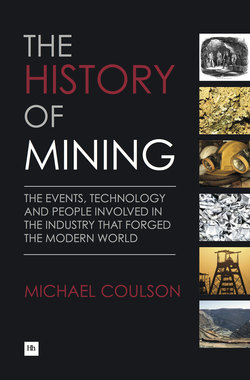Читать книгу The History of Mining - Michael Coulson - Страница 48
На сайте Литреса книга снята с продажи.
Hernando Cortez (1485-1547)
ОглавлениеCortez was one of the earliest and most infamous of Spain’s conquistadors who ravaged Central America in the early 16th century. His interest in Latin America was twofold – political and economic – reflecting his background as well-born but financially straitened. Like many Spaniards of that era Cortez was interested in gold and silver but unlike many of his contemporaries he eventually financed a number of precious metal mines in Cuba and Mexico.
Cortez was born in Medellin in Badajoz in northern Spain, his father Martin was an army officer and his mother Maria was a cousin of Francisco Pizarro, the conqueror of Peru. Cortez was educated at the University of Salamanca where it is believed he studied law. He did not complete his studies but at the age of 19 he sailed to Hispaniola (Haiti/Dominican Republic today) where he practiced as a notary. In 1509 he took part in the invasion of Cuba, where he materially enhanced his standing as a forceful leader; this led to administrative power within the new Cuban government and the allotment of land and other assets. It was at this stage that Cortez became involved in mining for the first time when he established an alluvial gold operation at Cuvanacan on the Duaban river in the east of the island, using a workforce of indigenous slaves that he had been allocated. The mining investment and his livestock operation generated great wealth for Cortez and he established a large estate and house near the mine workings.
By now he was a substantial figure in Spain’s Caribbean colonies and his former supporter the governor, Diego Velazquez, became jealous of his success. This was despite the fact that he had married Velazquez’s sister-in-law, Catalina Zuarez. Cortez was unfortunately a serial womaniser and was rumoured to have had a large number of children with both native and Spanish women. Catalina died childless in 1522 and in 1529 he married Juana Ramirez, with whom he had several children. Cortez, anxious for new challenges and perhaps realising that he had outgrown Cuba, raised an expedition to invade Mexico in 1519 where the Aztec empire was at its zenith, and sailed without final clearance from Velazquez. There he established a relationship with the Aztec king, Montezuma II, which Cortez turned to his considerable advantage as he acquired huge wealth in the form of gold and silver for the Spanish Crown.
Whilst Cortez much admired the advanced state of the Aztec civilisation he was ruthless in his treatment of both Montezuma and the Aztec people, essentially ripping the heart out of the civilisation through a combination of imported diseases like smallpox and the slaughter of countless natives. He eventually toppled Montezuma, destroying the Aztec capital, Tenochtitlan, and establishing Mexico City in its place.
It was after this that Cortez turned once more to mining, discovering silver in the Taxco district and gold in the Oaxaco and Michoacan districts. As in Cuba, these mining activities earned Cortez further huge wealth but this was a wealth and influence that worried the authorities. For this reason, as negative comment rose about his burgeoning power, Cortez returned to Spain to plead his case with the king, Charles V, and the king gave him support. But when he returned to Mexico his powers, which had included the position of governor, were greatly reduced – though he was retained as captain general – and he turned instead to exploring Mexico.
In 1541 Cortez returned to Spain to try and resurrect his reputation but he was the subject of legal actions and was shunned by the king. His financial situation was weakened by his fight to save his reputation and after several frustrating years in Spain he eventually decided to return to Mexico. His health was now failing and he died of pleurisy before he could sail. Cortez remains a controversial character, clever and brave but also cruel and ruthless, a loving father but a deeply flawed human being. His economic success was overshadowed by his political activities, particularly as a conquistador, but his role as a developer of gold and silver mines in Mexico and Cuba makes him perhaps Spain’s first known mining baron.
